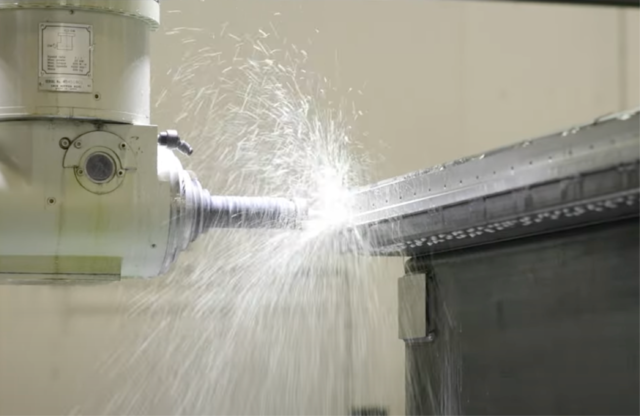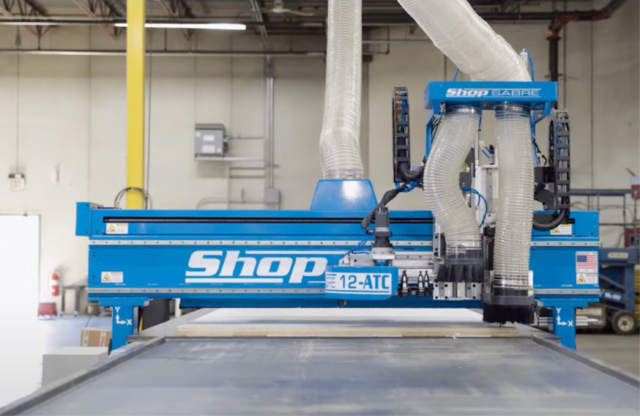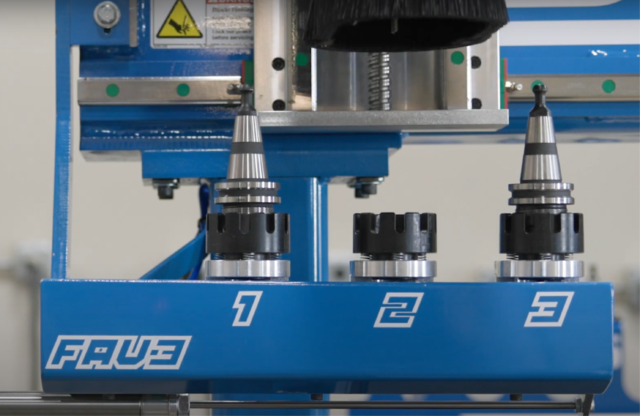What is a CNC Machine?

Key Takeaways
- A CNC machine is a computer-controlled tool that automates cutting, shaping, and fabrication with precision.
- CNC machines improve speed, consistency, and efficiency compared to manual methods.
- Common types include CNC mills, lathes, routers, lasers, plasma cutters, 3D printers, and more.
- CNC technology is used in industries ranging from cabinetry and furniture to metal fabrication and prototyping.
- Operators set up, program, and maintain these machines to ensure high-quality production.
If you’ve ever wondered what a CNC machine is, here’s the simple answer: A CNC machine is a computer-controlled tool that automates manufacturing processes like cutting, shaping, and drilling. Businesses use them to produce precise, repeatable parts across materials like wood, metal, plastic, and composites.
CNC machines help shops work faster, reduce waste, and take on more complex jobs than would be possible manually, but it can get a little complicated to try and impose this umbrella definition on all the machine types without pointing out specific functions they can perform.
Before we get into the different machines, though, let’s catch you up on the CNC basics!
CNC 101: The Basics
Instead of relying on manual levers, wheels, or hand tools, the machine reads a program and executes tasks automatically, producing highly accurate and repeatable results. CNC technology has transformed industries ranging from automotive and aerospace to woodworking, metal fabrication, and prototyping.
How CNC Machining Works
Design First Using CAD Software
Every CNC project starts with a digital blueprint. CAD, or Computer-Aided Design software, allows engineers, machinists, and makers to create detailed 2D or 3D models of a part or product. This is the foundation for the CNC process because every cut, carve, or hole is based on this design.
CAD software also allows for testing and adjustments before anything is physically cut, saving time and materials.
Convert to Code Using CAM Software
Once the design is complete, CAM (Computer-Aided Manufacturing) software translates it into machine-readable instructions, usually in G-code. This code tells the CNC machine exactly how to move: where to start, how fast to travel, which tools to use, and the depth or angle of each cut.
Modern CAM software can even optimize tool paths to reduce material waste and speed up production.
Set Up the Machine
Before the first cut, the machine must be prepared. This involves installing the appropriate cutting tools, securing the material, and calibrating the machine to ensure the coordinates match the design.
Proper setup is crucial to avoid errors, tool breakage, or wasted material. Even experienced operators spend a significant portion of their workflow on careful setup.
Test the Program
A trial run, often called a “dry run,” is performed to check the program for potential mistakes. This step helps prevent costly errors by ensuring the machine follows the correct path and the design is executed properly.
During the test, operators can adjust feed rates, tool positions, or sequence timing before actual production.
Production
With everything set, the CNC machine begins production. It can perform complex tasks like cutting, drilling, carving, and engraving with incredible precision. Whether producing a single prototype or hundreds of identical parts, the machine operates consistently, often faster than manual methods and with far less room for error.
Inspect and Adjust
Even with automated precision, inspection is essential. Parts are measured and verified against the original CAD design to ensure tolerances are met. Any minor deviations can be corrected for future runs, ensuring consistent quality.
This step is especially critical for industries with strict specifications, such as aerospace, medical device manufacturing, and automotive components.

Why It’s Worth Investing In CNC Machines
Large-scale manufacturers rely on CNC machines to deliver products efficiently, while smaller operations use them to take on high-precision work without needing a large team.
- Complex Tasks Made Simple: Intricate designs that would take hours manually can be completed quickly and accurately.
- Consistency Across Batches: Every part can match the original specifications exactly, no matter how many are produced.
- Material Efficiency: CNC machines optimize cutting paths to reduce waste and save on expensive materials.
- Expand Your Services: CNC systems can handle wood, metals, plastics, composites, and more, making them valuable across multiple industries.
- Innovation Opportunities: Engineers and designers can experiment with new geometries and techniques that were difficult or impossible to achieve by hand.

Common CNC Machine Types
As we touched on earlier, the question, “What is a CNC machine?” can cover a baseline understanding of general functions, but it’s not enough to cover the intricacies of all the different types.
Here’s a breakdown of the most popular machines businesses use, and what they excel at:
CNC Mills
CNC mills use rotating cutting tools to shape, drill, and contour materials, most commonly steel and other metals, making them ideal for creating durable, high-precision parts across industrial applications. Mills are ideal for parts that require exact tolerances, such as engine components, machine parts, and industrial prototypes.
For businesses, CNC mills can handle both one-off prototypes and high-volume production, making them versatile for almost any manufacturing setting.
CNC Lathes
Lathes work by spinning the material on an axis while stationary cutting tools shape it. They excel at producing cylindrical or round parts, like shafts, bushings, or furniture legs. CNC lathes reduce errors that come from manual turning and allow for repeated production of identical parts with minimal oversight.
Industries like automotive, aerospace, and custom furniture rely heavily on lathes for precision and efficiency.
CNC Routers
CNC routers are extremely versatile, especially for wood, plastics, and light metals such as Brass, Copper, and Aluminum. They’re commonly used for cabinetry, signage, furniture, and decorative carvings. Routers can cut complex shapes and designs with speed and repeatability, making them ideal for businesses that need both creativity and efficiency.
A single CNC router can replace several manual tools, saving time, reducing labor, and improving consistency across products.
Plasma Cutters
CNC Plasma cutters use high-temperature ionized gas to slice through metals quickly and accurately. They are perfect for sheet metal fabrication, industrial projects, and structural components. Plasma cutting is faster than traditional methods and can handle thick metal sheets that would take much longer with manual cutting tools.
For fabrication shops and industrial manufacturers, plasma cutters dramatically increase throughput while maintaining precise cuts.
Water Jet Cutters
Water jets use high-pressure water, sometimes mixed with abrasive particles, to cut through stone, metal, glass, and other hard materials. Unlike plasma or laser cutting, water jets don’t generate heat, preventing warping or structural changes. However, they do require more maintenance and can create a messy work environment compared to other cutting methods.
Industries like aerospace, automotive, and stone fabrication use water jets for intricate designs, tight tolerances, and materials sensitive to heat.
CNC Lasers
CNC laser machines use a focused beam of light to cut, engrave, or mark materials with extreme precision. They’re ideal for detailed metal fabrication, signage, and component production where accuracy and clean edges matter most. Laser systems are commonly used in industries like manufacturing, automotive, aerospace, and custom metalwork.
3D Printers
3D printers are additive manufacturing machines that build objects layer by layer. They are widely used for rapid prototyping, custom tooling, and producing complex parts that cannot be easily made with subtractive methods.
From functional prototypes to small-batch production, 3D printing allows businesses to innovate quickly while reducing material waste.
Other Specialized CNC Machines
CNC technology is not limited to the machines above. Other examples include:
- Foam Cutters: Perfect for custom packaging, props, and insulation.
- Embroidery Machines: Automate stitching for textiles and custom apparel.
- Turret Punchers: Efficiently create holes and shapes in sheet metal.
As you can see, CNC machines are versatile tools for any material, wood, metal, plastic, or composites. Knowing the different types helps you pick the right one for your projects and expand what your operation can do.

Common Applications Across Industries
On top of boasting a bunch of cool features, CNC machines are the backbone of modern manufacturing because they combine said features unlike anything you’ve ever seen. Across industries, businesses rely on them to produce high-quality products consistently.
Here’s how CNC machines are making an impact:
- Cabinetry and Furniture: From custom cabinetry to luxury furniture, CNC machines make intricate cuts and designs possible. They handle everything from complex joinery and curved edges to repeated patterns across drawers, MDF doors, closets, and more. Repeated patterns can be completed faster and more accurately than by hand, reducing errors and saving material.
- Signage and Engraving: Businesses producing custom signs, logos, or decorative carvings rely on CNC machines for sharp, repeatable results. Whether producing a single 2D sign, intricate 3D lettering, tactile Braille signage, or a batch of hundreds, CNC technology ensures every cut, engraving, and relief accurately matches the original design.
- Metal and Plastic Fabrication: Industrial applications, from automotive components to precision prototypes, depend on CNC machining to shape metals and plastics with exact tolerances. Small-batch production or one-off pieces can be handled efficiently, making CNC machines a vital tool in both startup and large-scale operations.
- Musical Instruments: Luthiers, drum makers, and other instrument producers use CNC machines for precise shaping of necks, shells, and soundboards. The repeatability of CNC machining ensures instruments are consistent, while still allowing for custom designs.
- Props and Exhibits: Stage sets, event displays, and museum exhibits often require complex shapes in foam, wood, or composites. CNC machines handle these projects quickly and accurately, even for highly detailed or multi-part assemblies.
- Architectural Millwork: Decorative moldings, panels, and custom trim benefit from CNC precision. Repeated patterns, curves, and complex designs can be produced consistently across large projects, ensuring architectural standards are met without manual labor bottlenecks.
Many businesses combine multiple CNC types to handle diverse projects without adding extra staff.
Choosing the Right CNC Machine
Understanding what a CNC machine is goes hand-in-hand with choosing the right one for your business. Selecting the right one is all about matching capabilities to your workflow, materials, and long-term goals.
Here’s what to consider:
- Workload and Growth: Think beyond your current projects. Choose a machine that can handle your existing workload and scale as your business grows. A CNC machine is an investment, and flexibility for future projects can prevent costly upgrades later.
- Material Needs: Different CNC machines handle different materials. Wood, plastics, metals, composites, and foam all have unique requirements. Make sure your machine can handle the range of materials your business relies on.
- Support and Training: CNC machines are complex tools. Lifetime support, accessible training resources, and responsive technical assistance can save time, reduce downtime, and make onboarding new operators smoother.
- Budget vs. ROI: Consider not just the upfront price, but long-term value. Maintenance, durability, energy use, and productivity all factor into a CNC machine’s return on investment. The most expensive machine isn’t always the best, and the cheapest may cost more in downtime and inefficiency.
Whether you’re a small shop, a mid-size manufacturer, or a large industrial operation, CNC machines provide a flexible solution that grows with your business. Machines like CNC routers, mills, and lathes allow you to expand capabilities, improve precision, and increase throughput, all while maintaining consistent quality.
A Quick Recap On CNC Machine Types, Functions, and Applications
|
Machine Type |
What It Does |
Typical Applications |
|
CNC Mill |
Cuts, drills, and shapes materials |
Metal parts, prototypes |
|
CNC Lathe |
Spins material while cutting |
Cylindrical parts, rods, spindles |
|
CNC Router |
2D, 2.5D, 3D Shaping of material – Carving, Engraving, Cutting of Wood, Plastic, and Light Metals. |
Cabinets, signage, furniture |
|
Plasma Cutter |
Cuts metal with a plasma torch |
Metal fabrication, industrial projects |
|
CNC Fiber Laser |
Uses focused light to cut metals |
Construction & carpentry, prototyping & R&D, plate processing, signs & décor |
|
Water Jet Cutter |
High-pressure water cuts hard materials |
Stone, glass, heat-sensitive metals |
|
3D Printer |
Adds material layer by layer |
Prototypes, plastic parts, custom objects |
Start Expanding What You Can Create Today
With the right combination of machine, software, and training, CNC technology gives businesses of all sizes the power to work faster, reduce waste, and maintain consistent quality across every project. And with ShopSabre, unlocking new opportunities, improving workflows, and staying competitive in today’s manufacturing landscape has never been easier.
Browse our homepage to see the full lineup of American-made CNC machines and find the perfect fit for your shop.


